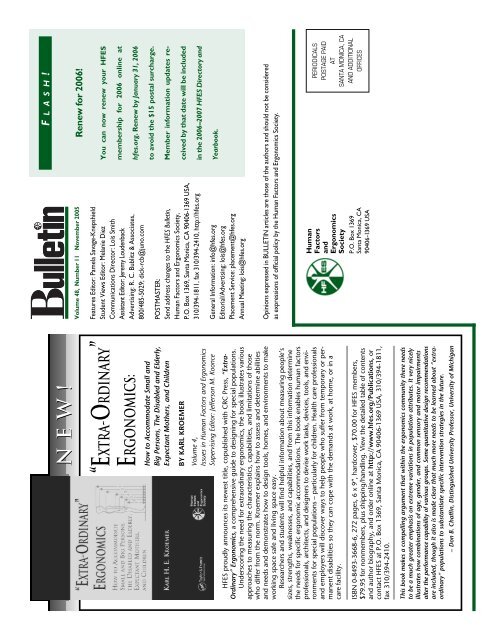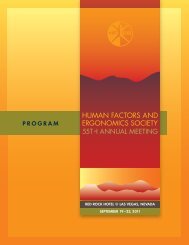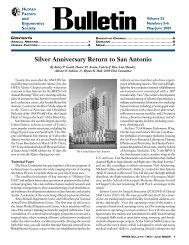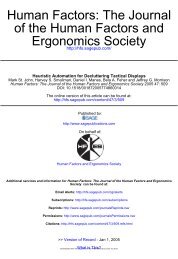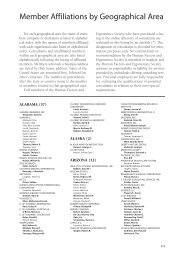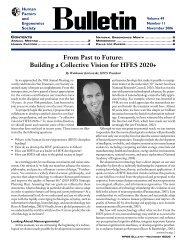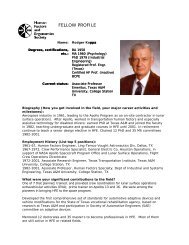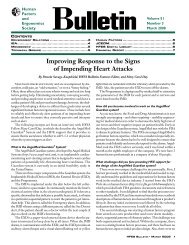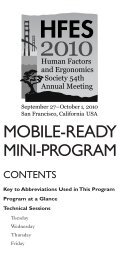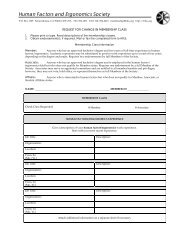Who Knows About Human Factors and Ergonomics? A Lot More ...
Who Knows About Human Factors and Ergonomics? A Lot More ...
Who Knows About Human Factors and Ergonomics? A Lot More ...
Create successful ePaper yourself
Turn your PDF publications into a flip-book with our unique Google optimized e-Paper software.
NEW!NEW!Volume 48, Number 11 November 2005“Extra-Ordinary”<strong>Ergonomics</strong>:How to Accommodate Small <strong>and</strong>Big Persons, The Disabled <strong>and</strong> Elderly,Expectant Mothers, <strong>and</strong> ChildrenBY KARL KROEMERVolume 4,Issues in <strong>Human</strong> <strong>Factors</strong> <strong>and</strong> <strong>Ergonomics</strong>Supervising Editor: Jefferson M. KoonceHFES proudly announces its newest title, copublished with CRC Press, “Extra-Ordinary” <strong>Ergonomics</strong>, a comprehensive guide to designing for special populations.Underscoring the need for extraordinary ergonomics, the book illustrates variousapproaches to measuring the characteristics, capabilities, <strong>and</strong> limitations of thosewho differ from the norm. Kroemer explains how to assess <strong>and</strong> determine abilities<strong>and</strong> needs <strong>and</strong> demonstrates how to design tools, homes, <strong>and</strong> environments to makeworking space safe <strong>and</strong> living space easy.Researchers <strong>and</strong> students will find helpful information about measuring people’ssizes, strengths, weaknesses, <strong>and</strong> capabilities, <strong>and</strong> from this information determinethe needs for specific ergonomic accommodations. The book enables human factorsprofessionals, architects, <strong>and</strong> designers to devise work tasks, devices, tools, <strong>and</strong> environmentsfor special populations – particularly for children. Health care professionals<strong>and</strong> employers will discover ways to help people who suffer from temporary or permanentdisabilities so they can cope with the dem<strong>and</strong>s at work, at home, or in acare facility.ISBN 0-8493-3668-6, 272 pages, 6 x 9”, hardcover, $70.00 for HFES members,$79.95 for nonmembers, plus shipping/h<strong>and</strong>ling. View the detailed table of contents<strong>and</strong> author biography, <strong>and</strong> order online at http://www.hfes.org/Publications, orcontact HFES at P.O. Box 1369, Santa Monica, CA 90406-1369 USA, 310/394-1811,fax 310/394-2410.BulletinHF ESFeatures Editor: Pamela Savage-KnepshieldStudent Views Editor: Melanie DiezCommunications Director: Lois SmithAssistant Editor: Jeremy LoudenbackAdvertising: R. C. Bublitz & Associates,800/485-5029; dick-rcb@juno.comPOSTMASTER:Send address changes to the HFES Bulletin,<strong>Human</strong> <strong>Factors</strong> <strong>and</strong> <strong>Ergonomics</strong> Society,P.O. Box 1369, Santa Monica, CA 90406-1369 USA,310/394-1811, fax 310/394-2410, http://hfes.orgGeneral Information: info@hfes.orgEditorial/Advertising: lois@hfes.orgPlacement Service: placement@hfes.orgAnnual Meeting: lois@hfes.orgOpinions expressed in BULLETIN articles are those of the authors <strong>and</strong> should not be consideredas expressions of official policy by the <strong>Human</strong> <strong>Factors</strong> <strong>and</strong> <strong>Ergonomics</strong> Society.<strong>Human</strong><strong>Factors</strong><strong>and</strong><strong>Ergonomics</strong>SocietyP.O. Box 1369Santa Monica, CA90406-1369 USA! F L A S H!Renew for 2006!You can now renew your HFESmembership for 2006 online athfes.org. Renew by January 31, 2006to avoid the $15 postal surcharge.Member information updates receivedby that date will be includedin the 2006–2007 HFES Directory <strong>and</strong>Yearbook.PERIODICALSPOSTAGE PAIDATSANTA MONICA, CAAND ADDITIONALOFFICESThis book makes a compelling argument that within the ergonomics community there needsto be a much greater emphasis on extreme variations in population attributes. It very nicelyillustrates how combinations of age, gender, <strong>and</strong> common sensory <strong>and</strong> motor impairmentsalter the performance capability of various groups. Some quantitative design recommendationsare included, though it also is made clear that much more needs to be learned about “extraordinary”populations to substantiate specific intervention strategies in the future.– Don B. Chaffin, Distinguished University Professor, University of Michigan


